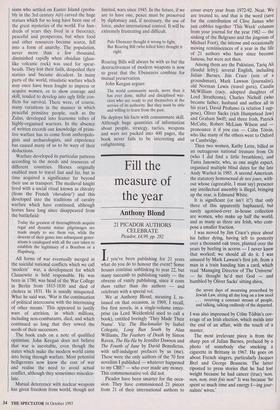The real and the true
Philip Warner
A HISTORY OF WARFARE by John Keegan Hutchins-on, £20, pp. 432 There have been numerous histories of warfare, varying from absurd picture books to scholarly surveys which attempted to be comprehensive but failed because they lost their way in detail. This one is different. John Keegan, who was a lecturer at Sand- hurst for many years and is now Defence Editor of the Daily Telegraph as well as being the author of a number of successful books, is here concerned with the develop- ment of styles of warfare. Although this survey is on broad lines his approach allows for some interesting detail, much of it graphic.
He observes that the national wars which have devastated Europe and certain coun- tries elsewhere stem from the theories of Clausewitz. Clausewitz had served in a Prussian army which was decisively beaten by the national, revolutionary armies of France. In consequence he felt that suc- cessful warfare in the future could only be conducted by politically motivated armies using all the resources of the state. This was 'true war'. Eventually it led to the first and second world wars.
Although Clausewitz was not necessarily the originator of the 'true war' theory, he certainly propagated it. The alternative was `real war', in which people fought as and when they chose, for a variety of reasons, economic, theocratic, or ritualistic. In 'real war' only a proportion of the population would be engaged (unless they were defeat- ed by some particularly bloodthirsty oppo- nent). Real wars are usually limited, and in some countries included tactics which avoided actual combat.
However, as 'civilisation' progressed, bringing with it more lethal forms of weapons, real war caused much death and misery. But, Keegan points out, war is not a 'natural' activity. Many primitive peoples were friendly to each other and to strangers until taught to be other- wise. However, the transition could be swift.
He sees early warfare as a cultural rather than a political activity and cites as exam- ples the Yanamono in South America, the Maring in New Guinea, the Maoris, the Aztecs and the Polynesians. The Polyne- sians who settled on Easter Island (proba- bly in the 3rd century AD) carved the huge statues which for so long have been one of the great mysteries of the world. For hun- dreds of years they lived in a theocracy, peaceful and prosperous, but when food and other resources became scarce, fell into a form of anarchy. The population, never more than a few thousand, diminished rapidly when obsidian (glass- like volcanic rock) was used for spear- heads. They lost their faith, despoiled their statues and became decadent. In many parts of the world, ritualistic warfare which may once have been fought to impress or acquire women, or to show courage and skill, tended to develop into ugly little con- flicts for survival. There were, of course, many variations in the manner in which peaceful primitive people, such as the Zulus, developed into fearsome tribes of highly-organised warriors. In the absence of written records our knowledge of primi- tive warfare has to come from anthropolo- gists and archaeologists, and experience has caused many of us to be wary of their deductions.
Warfare developed its particular patterns according to the needs and resources of different countries. Horses originally enabled men to travel fast and far, but in time acquired a significance far beyond their use as transport. The medieval knight lived with a social ritual known as chivalry (from the French `chevalerie) and this developed into the traditions of cavalry warfare which have continued, although horses have long since disappeared from the battlefield:
Today the greatest of thoroughbreds acquire regal and dynastic status: pilgrimages are made simply to see them run, while the descent of their genes into subsequent gener- ations is catalogued with all the care taken to establish the legitimacy of a Bourbon or a Hapsburg.
All forms of war eventually merged in the suicidal national conflicts which we call `modern' war, a development for which Clausewitz is held responsible. He was born in 1780, was head of the War College in Berlin from 1815-1830 and died of cholera in 1831. He is usually misquoted. What he said was, War is the continuation of political intercourse with the intermixing of other means.' This appeared to justify wars of attrition, in which millions, including non-combatants, died, and which continued so long that they sowed the seeds of their successors.
The book ends on a note of qualified optimism. John Keegan does not believe that war is inevitable, even though the states which make the modern world came into being through warfare. Most potential belligerents now know the cost of war and realise the need to avoid actual conflict, although they sometimes miscalcu- late.
Mutual deterrence with nuclear weapons has given freedom from world, though not limited, wars since 1945. In the future, if we are to have one, peace must be preserved by diplomacy and, if necessary, the use of force, under international control. It will be extremely frustrating and difficult.
Pale Ebenezer thought it wrong to fight, But Roaring Bill (who killed him) thought it right.
Roaring Bills will always be with us but the destructiveness of modern weapons is now so great that the Ebenezers combine for mutual preservation.
John Keegan argues:
The world community needs, more than it has ever done, skilful and disciplined war- riors who are ready to put themselves at the service of its authority. But they must be able and willing to learn from the past.
He deploys his facts with consummate skill. Although huge quantities of information about people, strategy, tactics, weapons and wars are packed into 400 pages, the book never fails to be interesting and enlightening.



























































 Previous page
Previous page